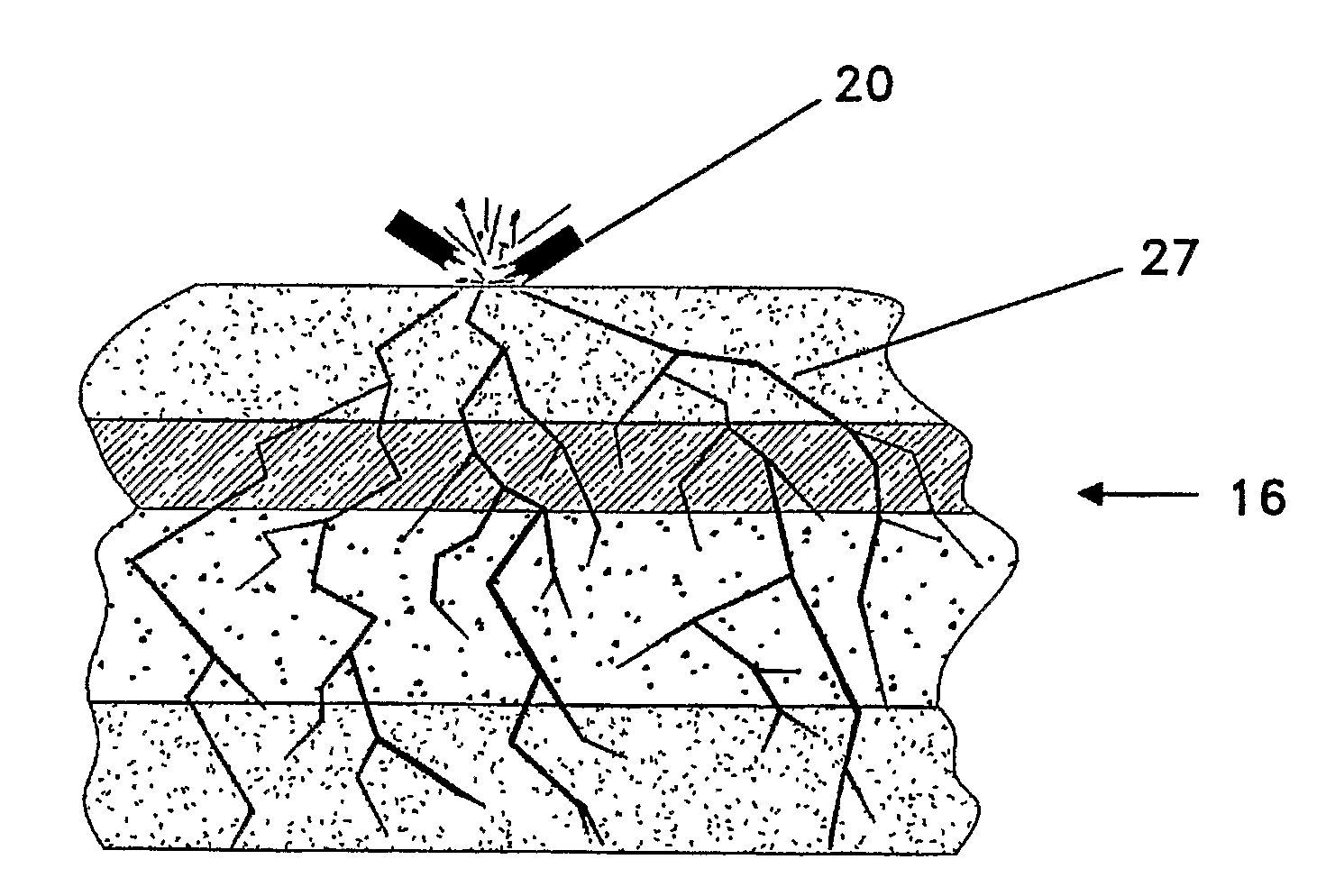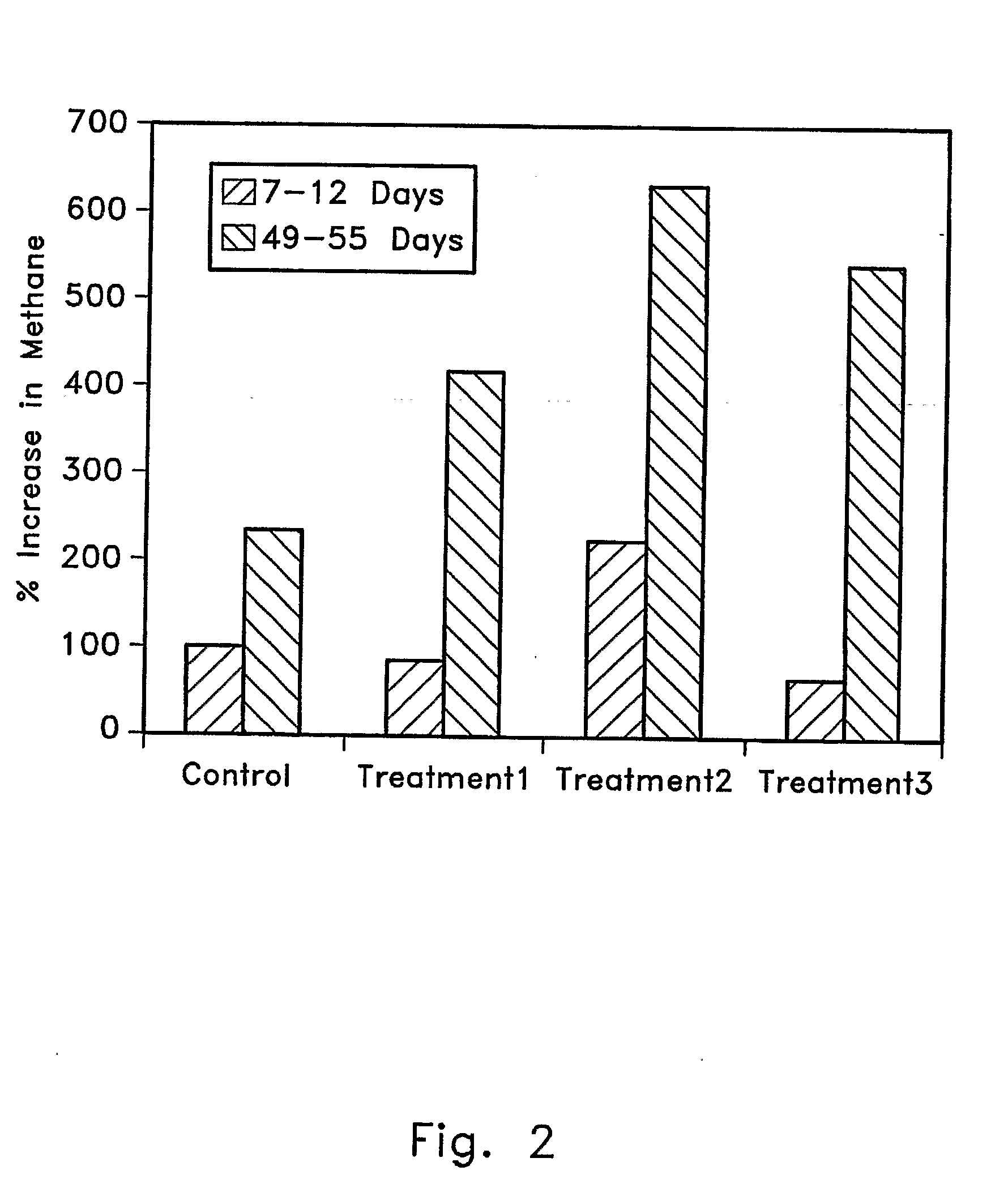Biogenic Methane Production Enhancement Systems
a biogenic methane and production enhancement technology, applied in the field of biogenic methane production, can solve the problems of lacking effective technology to identify and enhance biogenic methane production in coal seams, oil shale, etc., and achieve the effect of enhancing organic matter release and reducing sulfate reduction competition
- Summary
- Abstract
- Description
- Claims
- Application Information
AI Technical Summary
Benefits of technology
Problems solved by technology
Method used
Image
Examples
example 1
[0165]As an example, treatments were tested with oil shale in which results are shown in FIGS. 1 and 2. Treatment 1 includes nutrients. Treatment 2 includes milk and nutrients. Treatment 3 includes inoculated substances, milk and nutrients. In FIG. 1, the control was left at 100% at both 7-12 and 49-55 days and the percent increase was calculated relative to the control values. In FIG. 2, the control was set at 7-12 days at 100% and the percent increase was calculated relative to the control value at the first point.
example 2
[0166]Microbes were established in 160 mL glass serum bottles with septa to prevent oxygen exposure. Duplicates were established for each treatment, including non-amended sterile controls. Microbes were established so that 50 mL of headspace was remaining after setup for CH4 production. Microbes were stored between 20-25° C. throughout the study. Amounts of substrate and water used for microbe establishment are shown in Table 2.
TABLE 2Carbon source and water amounts used for microbe establishment.Amount of Carbon Source,Carbon SourcegWater, mLOil Shale75.063.0Coal64.354.0Lignite61.9520Peat75.063.0Contaminated Soil77.465.0
[0167]Data from baseline characterizations were used to calculate nutrient amendments in corresponding microbes. Analytical results indicated that nitrogen (N) and phosphorus (P) were limiting for an optimal molar ratio of 100:30:3. Concentrations of N and P were increased using NH4Cl and KH2PO4 respectively. Other additions included dump milk and bacterial inhibito...
example 3
[0168]A separate set of microbes were established to increase the bioavailability of organics. This was done by pre-treating the crushed oil shale with 1 M sodium hydroxide (NaOH). 1 M NaOH solution was added to the oil shale until a pH of 13 was attained and the mixture was allowed to react for 24 hours at room temperature and under nitrogen atmosphere. The pH was lowered to 9.8 by adding HCl before the addition of treatments and increasing the liquid volume to 63 mL. As before, the microbes were created anaerobically in the same manner as outlined before. The information Table 8 lists the microbes created along with corresponding amendments.
TABLE 8Nutrients and inhibitors added to groundwater (63 mL) mixed withpre-treated oil shale (75 g) with NaOH.Microbe IDGroundwater1No Additives21.9494 g KH2PO47.6601 g NH4Cl312.6 ml milk42.0245 g KH2PO47.9551 g NH4Cl12.6 ml milk5(Sterilized Groundwater)(Sterilized Oil Shale)6(Sterilized Oil Shale)No Amendments7(Sterilized Oil Shale)2.045 g KH2...
PUM
| Property | Measurement | Unit |
|---|---|---|
| temperature | aaaaa | aaaaa |
| compressive strength | aaaaa | aaaaa |
| pH | aaaaa | aaaaa |
Abstract
Description
Claims
Application Information
 Login to View More
Login to View More - R&D
- Intellectual Property
- Life Sciences
- Materials
- Tech Scout
- Unparalleled Data Quality
- Higher Quality Content
- 60% Fewer Hallucinations
Browse by: Latest US Patents, China's latest patents, Technical Efficacy Thesaurus, Application Domain, Technology Topic, Popular Technical Reports.
© 2025 PatSnap. All rights reserved.Legal|Privacy policy|Modern Slavery Act Transparency Statement|Sitemap|About US| Contact US: help@patsnap.com



